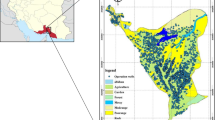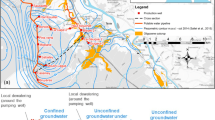Abstract
Groundwater quality sampling campaigns are crucial for the characterization and monitoring of aquifers, especially in urban settings where contamination have an anthropogenic origin due to common practices developed in urban areas. In Paraguay, the Patiño aquifer is located below the largest and most densely populated urban area, and supplies water to 31% of the country's population (approximately 2.1 million people), it has more than 8,000 potential pollution sources and over 2800 deep wells. Water quality campaigns are performed irregularly, and there is no characterization of water type or water quality for the aquifer. This study presents a novel well selection protocol for the purposes of a water quality campaign and the results of its application. This protocol is based on a multi-objective evolutionary algorithm that uses known risk of contamination data, well location, and accessibility to wells (i.e. public vs. privately owned wells) to maximize the chances of finding groundwater contamination. In total, twenty-one water quality parameters were evaluated in 66 wells that were selected based on our sampling protocol. Of these wells, 83% were found to have values outside the permissible limit, according to the regulations considered. In addition, the presence of nitrate concentrations was found to be above the permissible limits in 42% of the wells. Our well selection protocol had a 50% success rate at finding samples outside the permissible limits, while two previous campaigns with no optimized selection protocol showed a 21 and 37% success rate.










Similar content being viewed by others
References
Alzraiee AH, Bau DA, Garcia LA (2013) Multiobjective design of aquifer monitoring networks for optimal spatial prediction and geostatistical parameter estimation. Water Resour Res 49(6):3670–3684. https://doi.org/10.1002/wrcr.20300
Aller L, Bennett T, Lehr JH, Petty RJ, Hackett G (1987) DRASTIC: A standardized system for evaluating ground water pollution potential using hydrogeologic settings. US Environmental Protection Agency, Washington, DC, p 455
Baez L, Villalba C, Nogues JP (2019) Comparison of contaminant-specific risk maps for an urban aquifer: Patiño aquifer case. Environ Earth Sci 78(5):137. https://doi.org/10.1007/s12665-019-8141-3
Bashi-Azghadi SN, Kerachian R (2010) Locating monitoring wells in groundwater systems using embedded optimization and simulation models. Sci Total Environ 408(10):2189–2198. https://doi.org/10.1016/j.scitotenv.2010.02.004
Bertrand G, Hirata R, Pauwels H, Cary L, Petelet-Giraud E, Chatton E, Batista J (2016) Groundwater contamination in coastal urban areas: anthropogenic pressure and natural attenuation processes. Example of Recife (PE State, NE Brazil). J Contam Hydrol 192:165–180. https://doi.org/10.1016/j.jconhyd.2016.07.008
Brown RM, McClelland NI, Deininger RA, O’Connor MF (1972) A water quality index—crashing the psychological barrier. In Indicators of environmental quality Springer, Boston
CKC-JNS (2007) Estudio de Políticas y Manejo Ambiental de Aguas Subterráneas en el Área Metropolitana de Asunción—Acuífero Patiño. Asunción, Paraguay
Deb K (2011) Multi-objective optimisation using evolutionary algorithms: an introduction. In: Multi-objective evolutionary optimisation for product design and manufacturing. Springer, London, pp 3–34
Deb K, Pratap A, Agarwal S, Meyarivan TAMT (2002) A fast and elitist multiobjective genetic algorithm: NSGA-II. IEEE Trans Evol Comput 6(2):182–197. https://doi.org/10.1109/4235.996017
DGEEC (2013) Compendio Estadístico Año 2012. https://www.dgeec.gov.py/Publicaciones/Biblioteca/compendio2012/Compendio%20Estadistico%202012.pdf. Accessed 27 Mar 2020
Dhar A (2013) Geostatistics-based design of regional groundwater monitoring framework ISH. J Hydraul Eng 19(2):80–87. https://doi.org/10.1080/09715010.2013.787713
Dhar A, Patil RS (2012) Multiobjective design of groundwater monitoring network under epistemic uncertainty. Water Resources Manag 26(7):1809–1825. https://doi.org/10.1007/s11269-012-9988-1
Di Pierro F (2006) Many-objective evolutionary algorithms and applications to water resources engineering. Doctoral dissertation University of Exeter
EU (1998) Directive related with quality of water intended for human consumption. 98/83/EC Official Journal of the European Communities L330: 32–54
Facetti JF, Nunez R, Gomez C, Ojeda J, Bernal C, Leon-Ovelar R, Carvallo F (2019) Methyl tert-butyl ether (MtBE) in deep wells of the Patiño Aquifer, Paraguay: a preliminary characterization. Sci Total Environ 647:1640–1650. https://doi.org/10.1016/j.scitotenv.2018.08.062
Feitosa FAC, Manoel Filho J, Feitosa EC, Demetrio JGAC (2008) Hidrogeología: conceptos y aplicaciones. 3.ed. Fortaleza:Asociación Española para la Inteligencia Artificial CPRM, 812 p
Flörke M, Schneider C, McDonald RI (2018) Water Competition between Cities and Agriculture Driven by Climate Change and Urban Growth. Nat Sustain 1(1):5. https://doi.org/10.1038/s41893-017-0006-8
Gadea M (2019) Determinación de los Niveles de Salinidad del Acuífero Patiño Reportes científicos de la FACEN 10(2). https://doi.org/10.18004/rcfacen.2019.10.2.77
Gohar AA, Cashman A, Ward FA (2019) Managing food and water security in small island states: new evidence from economic modelling of climate stressed groundwater resources. J Hydrol 569:239–251. https://doi.org/10.1016/j.jhydrol.2018.12.008
Grischek T, Nestler W, Piechniczek D, Fischer T (1996) Urban groundwater in Dresden. Germany Hydrogeol Journal 4(1):48–63. https://doi.org/10.1007/s100400050088
Güler C, Thyne GD, McCray JE, Turner KA (2002) Evaluation of graphical and multivariate statistical methods for classification of water chemistry data. Hydrogeol J 10:455–474. https://doi.org/10.1007/s10040-002-0196-6
Gulgundi MS, Shetty A (2018) Groundwater quality assessment of urban bengaluru using multivariate statistical techniques. Appl Water Sci 8(1):43. https://doi.org/10.1007/s13201-018-0684-z
Houben G, Rojas C, Romero A, Cabral N, Olavarrieta A, Enciso C, Brunelli ML, Colmán F, Silvero J, Almada M, Cruzans G (2012) Informe técnico: Investigación de la calidad del agua. Cuenca hídrica del arroyo San Lorenzo, Departamento Central. Proyecto “Manejo sostenible y protección de las aguas subterráneas en Paraguay”(PAS-PY). In: Secretaría del Ambiente. http://www.mades.gov.py/wp-content/uploads/2018/06/Informe-Final-San-Lorenzo.pdf. Accessed 22 Feb 2020
Ikem A, Osibanjo O, Sridhar MKC, Sobande A (2002) Evaluation of groundwater quality characteristics near two waste sites in Ibadan and Lagos. Nigeria Water, Air, and Soil Pollution 140(1–4):307–333. https://doi.org/10.1023/A:1020165403531
INCLAM-HQA (2017) Diagnóstico del Acuífero Patiño, en Proyecto BID PR-T 1207 “Estudio de Recursos Hídricos y Vulnerabilidad Climática del Acuífero Patiño”. http://www.mades.gov.py/wp-content/uploads/2019/09/PR-T1207-Diagnostico.pdf. Accessed 10 Mar 2021
Kløve B et al (2014) Climate change impacts on groundwater and dependent ecosystems. J Hydrol 518:250–266. https://doi.org/10.1016/j.jhydrol.2013.06.037
Kollat JB, Reed PM (2006) Comparing state-of-the-art evolutionary multi-objective algorithms for long-term groundwater monitoring design. Adv Water Resour 29(6):792–807. https://doi.org/10.1016/j.advwatres.2005.07.010
Law No. 1614 (2000) General regulatory and tariff framework of the public service for the provision of drinking water and sanitary sewerage for the Republic of Paraguay, Congress of the Paraguayan Nation and Sanitary Services Regulatory Entity (ERSSAN). Asuncion, Paraguay, November, 2000. https://www.bacn.gov.py/leyes-paraguayas/1694/ley-n-1614-general-del-marco-regulatorio-y-tarifario-del-servicio-publico-de-provision-de-agua-potable-y-alcantarillado-sanitario-para-la-republica-del-paraguay. Accessed 08 Mar 2021
Nas B, Berktay A (2010) Groundwater quality mapping in urban groundwater using GIS. Environ Monit Assess 160(1–4):215–227. https://doi.org/10.1007/s10661-008-0689-4
Newcomer ME, Gurdak JJ, Sklar LS, Nanus L (2014) Urban recharge beneath low impact development and effects of climate variability and change. Water Resour Res 50(2):1716–1734. https://doi.org/10.1002/2013WR014282
Nobre RCM, Rotunno OC, Mansur WJ, Nobre MMM, Cosenza CAN (2007) Groundwater vulnerability and risk mapping using GIS, modeling and a fuzzy logic tool. J Contaminant Hyrol 94(3–4):277–292. https://doi.org/10.1016/j.jconhyd.2007.07.008
Piper AM (1944) A Graphic Procedure in the Geochemical Interpretation of Water-Analyses. Trans Am Geophys Union 25:914–923. https://doi.org/10.1029/TR025i006p00914
PostGIS (2015) Spatial and Geographic objects for PostgreSQL. Open source geospatial foundation project. https://www.postgis.net/. Accessed 24 Mar 2020
PostgreSQL B (1996) PostgreSQL: The world's most advanced open source ralational database. Web resource. https://www.postgresql.org/about/. Accessed 24 Mar 2020
Robinson H, Gronow J (1992) Groundwater protection in the UK: assessment of the landfill leachate source-term. JIWMEZ 6(2):229–236
Rothwell JJ, Robinson SG, Evans MG, Yang J, Allott TEH (2005) Heavy metal release by peat erosion in the Peak District, southern Pennines. UK Hydrol Processes 19(15):2973–2989. https://doi.org/10.1002/hyp.5811
Rusydi AF (2018) Correlation between conductivity and total dissolved solid in various type of water: a review. In: Paper presented at the Global Colloquium on GeoSciences and Engineering
Sadat-Noori SM, Ebrahimi K, Liaghat AM (2014) Groundwater quality assessment using the water quality index and GIS in Saveh-Nobaran aquifer. Iran Environ Earth Sci 71(9):3827–3843. https://doi.org/10.1007/s12665-013-2770-8
Sagar SS, Chavan RP, Patil CL, Shinde DN, Kekane SS (2015) Physico-chemical parameters for testing of water-A review. Int J Chem Stud 3(4):24–28
Santiago A, Dorronsoro B, Nebro AJ, Fraire H (2016) Un nuevo método de estimación de densidad para problemas de optimización con tres objetivos usando metaheurısticas. In: XVII Conferencia de la Asociación Española para la Inteligencia Artificial, 2016. pp 345–354
TNO (2001) Informe técnico: Estudio del Acuífero Patiño. Fortalecimiento de los Estudios Hidrogeológicos del SENASA (FEHS). Asunción, Paraguay
Varol S, Davraz A (2015) Evaluation of the groundwater quality with WQI (Water Quality Index) and multivariate analysis: a case study of the Tefenni plain (Burdur/Turkey). Environ Earth Sci 73(4):1725–1744. https://doi.org/10.1007/s12665-014-3531-z
WHO (2008) Guidelines for drinking-water quality, 3rd edition: Volume 1 - Recommendations. Geneva
WHO (2017) Guidelines for drinking-water quality: 4th edition incorporating first addendum. Geneva
Wright J (2004) Environmental chemistry. Routledge
Yeh WW (2015) Optimization methods for groundwater modeling and management. Hydrogeol J 23(6):1051–1065. https://doi.org/10.1007/s10040-015-1260-3
Zendehbad M, Cepuder P, Loiskandl W, Stumpp C (2019) Source identification of nitrate contamination in the urban aquifer of Mashhad. Iran J Hydrol 25:100618. https://doi.org/10.1016/j.ejrh.2019.100618
Acknowledgements
This study was supported by the Consejo Nacional de Ciencia y Tecnología (CONACyT) through PROCIENCIA, in the project framework INV-190 Monitoring and simulation of transport of contaminants in urban areas of the Patiño aquifer. Program resources Fondo para la Excelencia de la Educación e Investigación—FEEI of FONACIDE, and by the Facultad Politécnica—Universidad Nacional de Asunción. In addition, it was supported by the Ministerio del Ambiente y Desarrollo Sostenible and the Ente Regulador de Servicios Sanitarios. The authors would like to acknowledge the independent reviewers who gave valuable insights and suggestions to this work.
Author information
Authors and Affiliations
Corresponding author
Additional information
Publisher's Note
Springer Nature remains neutral with regard to jurisdictional claims in published maps and institutional affiliations.
Rights and permissions
About this article
Cite this article
Báez, L., Ávalos, C., von Lücken, C. et al. Designing and validating a groundwater sampling campaign in an unmonitored aquifer: Patiño aquifer case. Environ Earth Sci 80, 406 (2021). https://doi.org/10.1007/s12665-021-09706-3
Received:
Accepted:
Published:
DOI: https://doi.org/10.1007/s12665-021-09706-3




